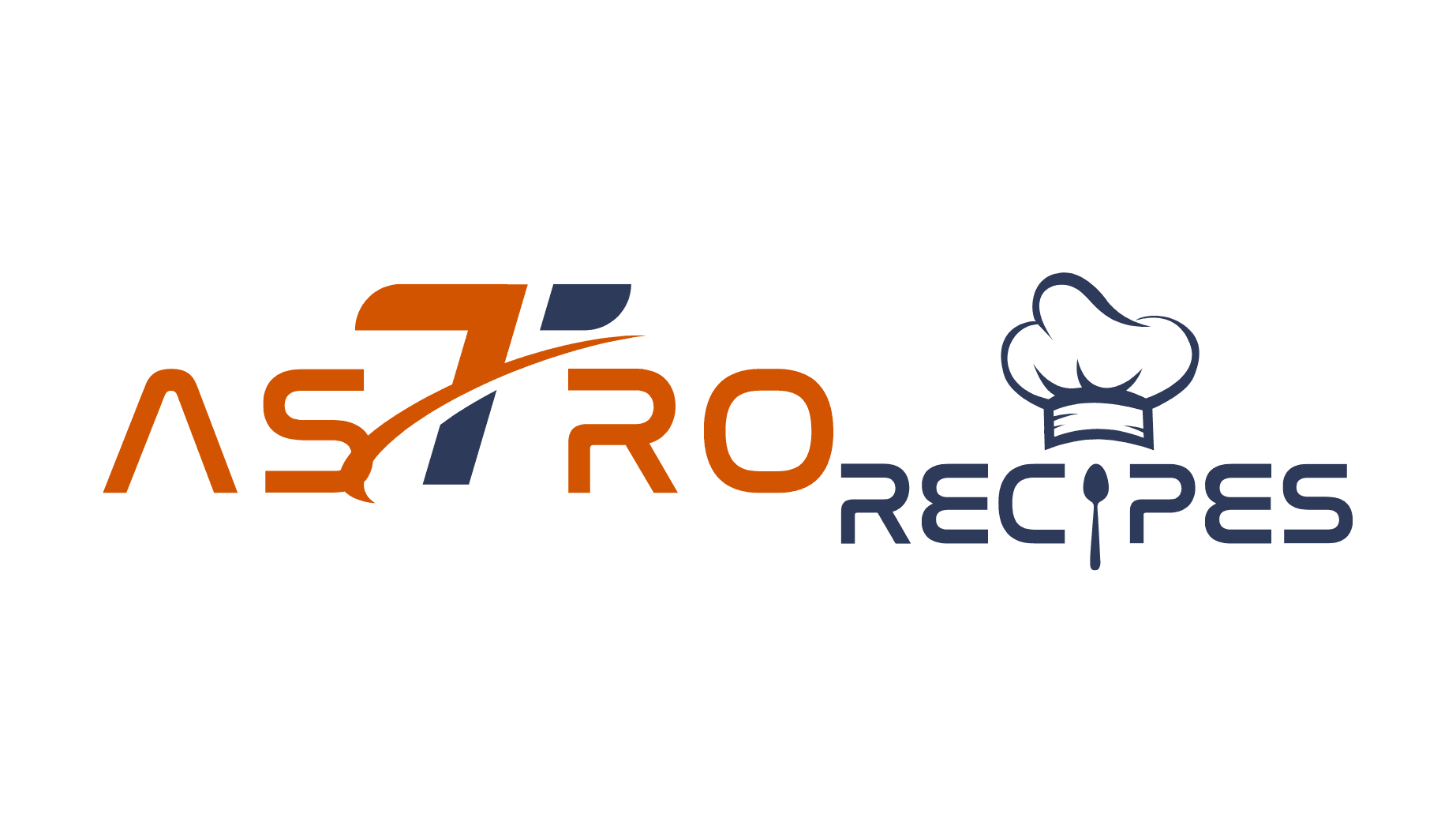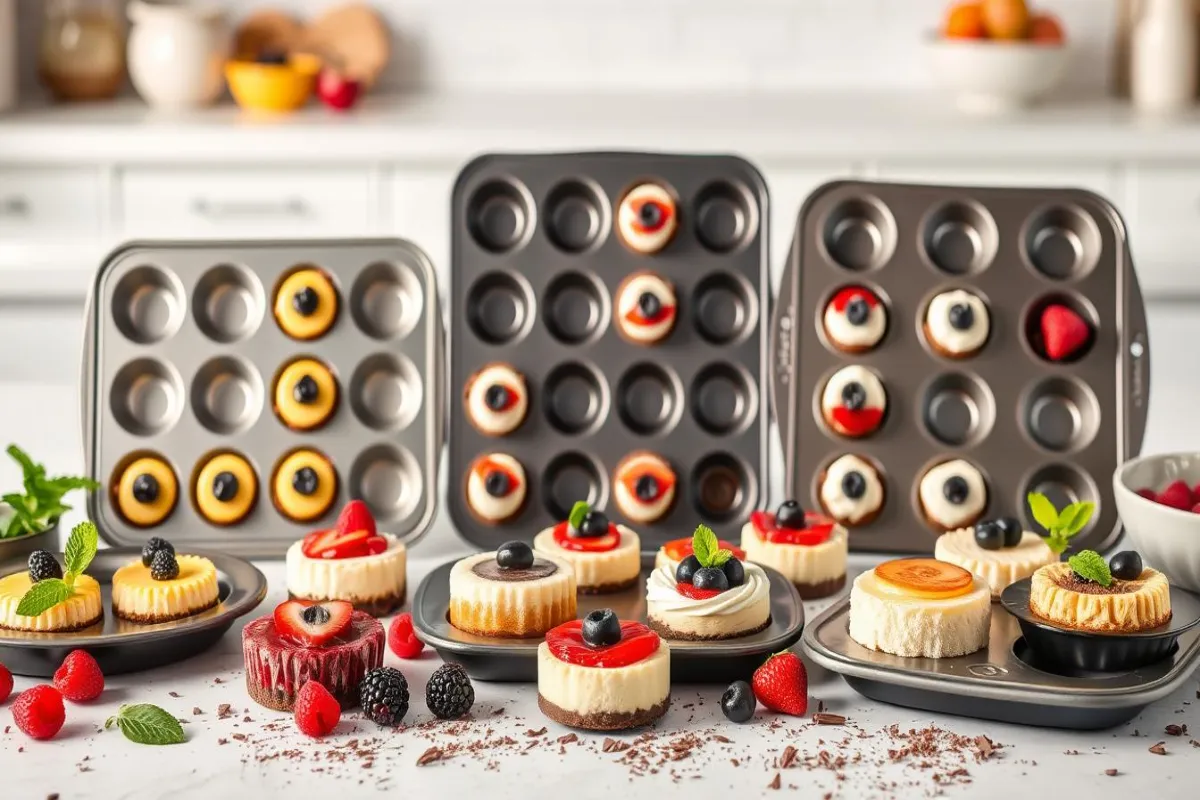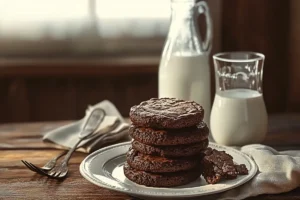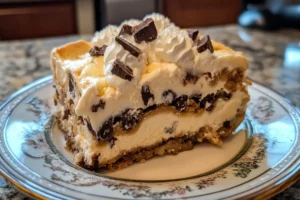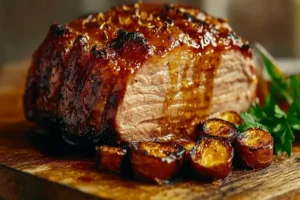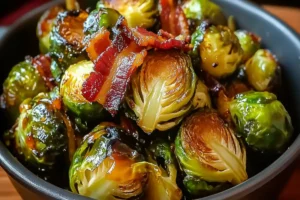Every baker knows the magic of a perfectly portioned dessert. My journey with mini cheesecake pans started after a dinner party disaster. My traditional cheesecake crumbled, ruining the evening. That's when I found individual cheesecake molds - a game-changer for home bakers. Choosing the right mini cheesecake pan can change your baking game. These molds let you make restaurant-quality desserts easily. They're perfect for gatherings or controlling portion sizes, giving you consistent results. In this guide, we'll look at five top mini cheesecake pans. We'll cover everything from 4-inch pans to versatile sets. You'll find the perfect tool to make delicious bite-sized treats that wow your loved ones. We've picked our selection based on material quality, heat resistance, and performance. Get ready to find the best mini cheesecake pans for your dessert dreams.
Table of contents
- Understanding Mini Cheesecake Pans and Their Purpose
- Essential Features of Quality Mini Cheesecake Pans
- Mini Cheesecake Pan Sizes and Capacities
- Materials and Construction Quality
- Non-Stick Coatings and Their Importance
- Temperature Resistance and Oven Safety
- Comparing Silicone vs Metal Mini Cheesecake Pans
- Cleaning and Maintenance Guidelines
- Storage Solutions for Mini Cheesecake Pans
- Price Range and Value Considerations
- Popular Brands in the Market
- Common Issues and How to Avoid Them
- Tips for Perfect Mini Cheesecakes
- Conclusion
- FAQ
Understanding Mini Cheesecake Pans and Their Purpose
Mini cheesecake pans are a game-changer for home bakers and dessert lovers. They make creating delicious desserts easy and stylish. These special pans help you bake with precision and flair.
Benefits of Individual Portion Sizes
Mini cheesecake pans bring many benefits to your baking. They allow you to:
- Create uniform desserts every single time
- Serve perfectly sized individual treats
- Experiment with multiple flavor combinations in one batch
- Reduce food waste
"Small bites, big flavors – that's the magic of mini cheesecakes!"
Material Types and Their Impact on Baking
Choosing the right material for your non-stick dessert cup is key. A silicone pan offers easy release, while metal pans give crisp edges and even heat.
| Material | Heat Distribution | Release Ease |
|---|---|---|
| Metal | Excellent | Good |
| Silicone | Moderate | Excellent |
Common Features to Consider
When looking for a mini cheesecake baking set, consider these features:
- Non-stick coating
- Removable bottom
- Depth of individual cups
- Number of cavities
- Overall durability
Pro tip: Choose a pan that matches your specific baking needs and recipe requirements.
Essential Features of Quality Mini Cheesecake Pans
Choosing the right mini cheesecake pan can change your baking game. A top-notch cupcake cheesecake maker does more than look good. It has features that make your desserts stand out.
- Even heat distribution for consistent baking
- Sturdy construction that prevents warping
- Removable bases for easy cake extraction
- Non-stick surfaces that ensure clean release
Professional bakers know that the right pan is key. Material quality and design precision are vital for perfect mini cheesecakes.
A great mini cheesecake pan is an investment in culinary excellence.
For your next baking project, consider these must-have pan features:
| Feature | Importance | Impact on Baking |
|---|---|---|
| Removable Bottom | High | Easy cake removal |
| Non-Stick Coating | Critical | Prevents sticking |
| Material Durability | Essential | Consistent performance |
Your ideal mini cheesecake pan should be durable, conduct heat well, and release cakes easily. Look for pans with strong edges and top-notch non-stick surfaces. This way, you’ll get pro-level results every time.
Mini Cheesecake Pan Sizes and Capacities
Finding the right mini cheesecake pans can change how you make desserts. There are many sizes and shapes of individual cheesecake molds. They help you make treats that are just the right size for any event.
Standard Measurements for Mini Pans
Choosing the right mini cheesecake muffin tin is key. Most individual cheesecake bakeware has standard sizes:
- 4-inch diameter individual cheesecake molds
- Mini pans with 12-cavity configurations
- Depth ranges from 1 to 2 inches
Portion Control Guidelines
Portion control cheesecake dishes are great for those watching their diet. A mini cheesecake baking set lets you make servings that are just right. Each serving is usually 2-3 ounces.
"Small desserts, big flavors - that's the magic of mini cheesecake pans!" - Pastry Chef Emma Richards
Serving Size Recommendations
Your mini cheesecake pan is perfect for many events:
- Buffet settings: 2-3 mini cheesecakes per person
- Dinner parties: 1 mini cheesecake per guest
- Cocktail events: Bite-sized portions for easy handling
Think about how many guests you’ll have and how much you want each to eat. This will help you pick the perfect pan for your dessert.
Materials and Construction Quality
Choosing the right materials for your silicone baking pan is key. Professional bakers know that the quality of non-stick dessert cups is vital. It helps in making perfect mini cheesecakes.
Different materials have their own benefits for bakers. Let’s look at what makes a top-notch mini cheesecake pan:
- Aluminized steel provides exceptional heat distribution
- FDA-approved non-stick coatings ensure food safety
- Durable materials prevent warping during high-temperature baking
Top pans use special metals for better performance. Aluminum, manganese, iron, and vanadium make the pan strong and good at conducting heat.
"The right pan can elevate your baking from good to extraordinary." - Professional Pastry Chef
When picking a mini cheesecake pan, think about these important features:
| Material Property | Performance Impact |
|---|---|
| Heat Conductivity | Ensures even baking and consistent results |
| Non-Stick Surface | Easy release and simple cleaning |
| Durability | Long-lasting performance and reliability |
Your perfect silicone baking pan should handle high temperatures up to 450°F. It should also have a seamless non-stick surface. And it should last for many years, giving you reliable baking experiences.
Non-Stick Coatings and Their Importance
Choosing a mini cheesecake baking set with non-stick surfaces is key. About 75% of cheesecake pans now have non-stick coatings. This makes baking easier and more fun for home bakers.
Knowing about different non-stick surfaces helps pick the right mini cheesecake pan. This is important for your baking needs.
Types of Non-Stick Surfaces
- Ceramic Coating: Provides excellent heat distribution
- Silicone-Based Coating: Offers superior release properties
- Traditional Non-Stick Surfaces: Most common in non-stick dessert cups
Maintenance and Care Tips
Keeping your non-stick coating in good shape is important. Experts suggest these care tips:
- Always use soft utensils when handling non-stick surfaces
- Avoid metal scrapers or abrasive cleaning materials
- Hand wash with mild detergent
- Store carefully to prevent scratching
"Protecting your non-stick coating is key to maintaining the quality of your individual cheesecake bakeware." - Baking Professionals
| Coating Type | Durability | Heat Resistance |
|---|---|---|
| Ceramic | High | Up to 450°F |
| Silicone-Based | Medium | Up to 400°F |
| Traditional Non-Stick | Low-Medium | Up to 350°F |
By choosing the right non-stick surface and following care tips, your mini cheesecake pan will last long. You’ll enjoy many baking experiences.
Temperature Resistance and Oven Safety
Choosing the right mini cheesecake pan is key to baking success. Your pan, whether silicone or metal, must handle high heat well. This ensures your baking is safe and effective.
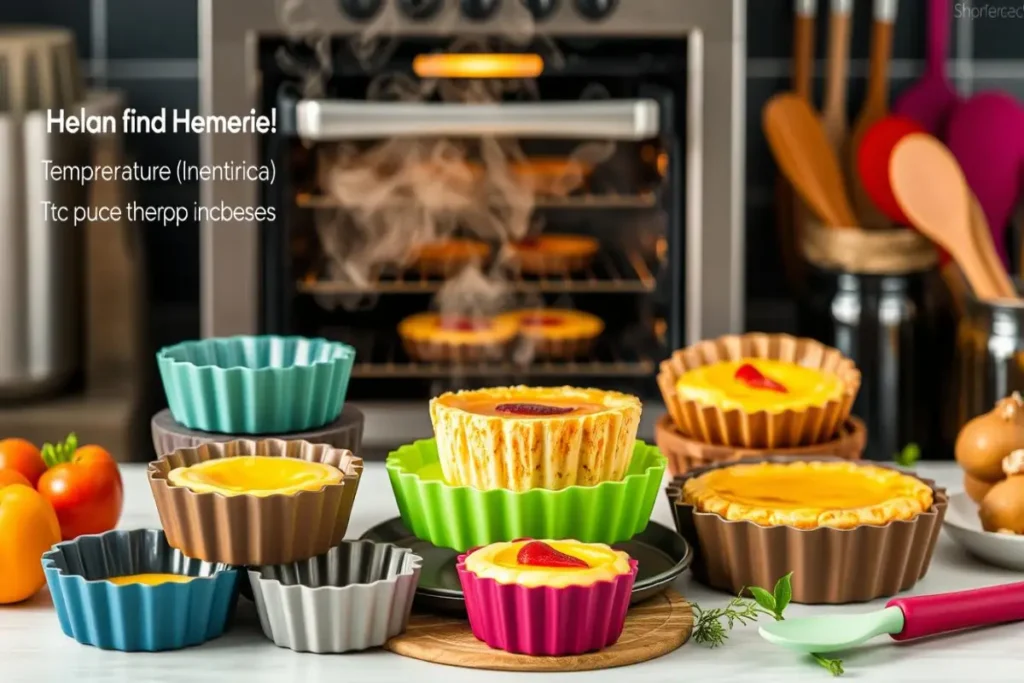
Silicone pans can go up to 450°F (230°C)
- Metal pans can reach 550°F (285°C)
- Anodized aluminum pans heat up and cool down fast
"Knowing your pan's temperature limits prevents baking disasters and ensures perfect mini cheesecakes every time."
When picking a mini cheesecake pan, look for these safety features:
- Check the max temperature the maker suggests
- Make sure it’s free from harmful chemicals like PFOA
- Look for materials that heat evenly
Pro tip: Always use oven mitts and handle hot pans with extreme caution to prevent burns or accidents.
Comparing Silicone vs Metal Mini Cheesecake Pans
Bakers have to choose between silicone and metal pans for individual cheesecakes. Each has its own benefits that can change how your cheesecakes turn out.
Metal pans are great for precise baking. They heat up evenly, making edges crisp. They’re also durable and reliable for pros.
Pros of Metal Pans
- Excellent heat distribution
- Crisp, golden edges
- Long-lasting durability
- Precise shape retention
Pros of Silicone Pans
- Flexible removal of cheesecakes
- Lightweight design
- Easy to clean
- Non-stick surface
Silicone pans are super for getting cheesecakes out without breaking them. They’re soft, making it easy to remove the cheesecakes. But, they might not heat up as well as metal.
"Choose your pan wisely - it's the foundation of perfect mini cheesecakes!" - Professional Baker
Durability Considerations
Metal pans last longer than silicone. It’s smart to buy good metal pans for better baking over time. Silicone pans can wear out and lose their non-stick surface.
What you choose depends on what you like, how often you bake, and what you want your cheesecakes to look like. Both can make amazing mini cheesecakes if used right.
Cleaning and Maintenance Guidelines
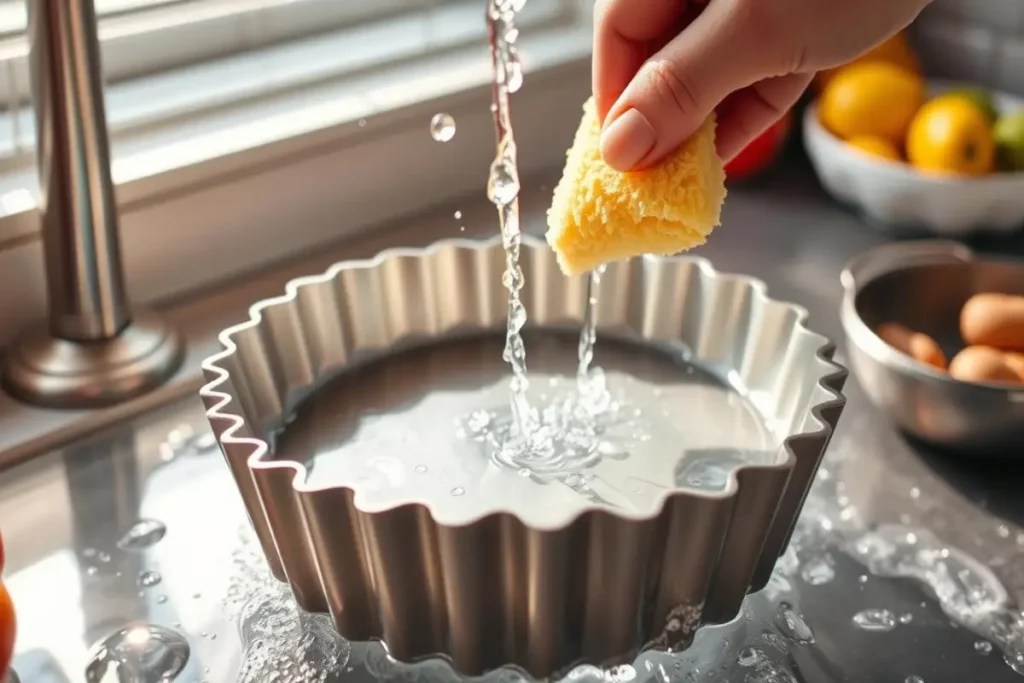
Keeping your non-stick dessert cups in top shape is key. They last longer if you clean them right. Metal and silicone pans need different cleaning methods, so it’s important to know the best way to clean each.
For metal mini cheesecake pans, here’s what you should do:
- Let the pan cool down completely after baking
- Wash it with warm water and gentle dish soap
- Stay away from harsh scrubbers that can harm the non-stick coating
- Wipe it dry with a soft cloth to stop rust
Silicone bakeware is easier to care for. Unlike metal pans, you can usually wash silicone in the dishwasher. It’s also great because it doesn’t rust, chip, or dent easily.
"Clean baking tools are the secret to perfect desserts every time!" - Professional Pastry Chef
How you dry your mini cheesecake pan is important. You can:
- Let it air dry on the counter
- Warm it up in the oven for 2-3 minutes
- Use a clean, soft towel to dry it quickly
Where you store your mini cheesecake pan is just as important as how you clean it. Keep it in a cool, dry spot. Don’t pile heavy things on top of it to avoid damage.
Storage Solutions for Mini Cheesecake Pans
Storing your mini cheesecake baking set needs careful planning. This protects your individual cheesecake molds and saves kitchen space. The right storage keeps your bakeware in great shape for future use.
Here are some smart ways to store your mini cheesecake pans:
- Stack pans vertically using protective dividers
- Invest in stackable storage containers
- Use drawer organizers designed for bakeware
- Hang pans on wall-mounted racks
It’s important to protect non-stick surfaces. Wrap each pan in soft cloth or use silicone separators to prevent scratching. If you have little kitchen space, try these creative ideas:
"Smart storage is about maximizing space while preserving your baking tools' quality." - Professional Baker's Tip
| Storage Method | Pros | Cons |
|---|---|---|
| Vertical Stacking | Space-efficient | Requires careful placement |
| Wall-Mounted Rack | Easy access | Requires wall space |
| Drawer Organizer | Protects from dust | Limited capacity |
Always clean and dry your mini cheesecake molds before storing. This stops rust and keeps them non-stick. Follow these tips to keep your mini cheesecake baking set in perfect shape for many baking sessions.
Price Range and Value Considerations
Finding the right mini cheesecake pan is about finding a balance between cost and quality. Your bakeware can really make a difference in your baking. Knowing the price ranges and what you get for your money will help you choose wisely.
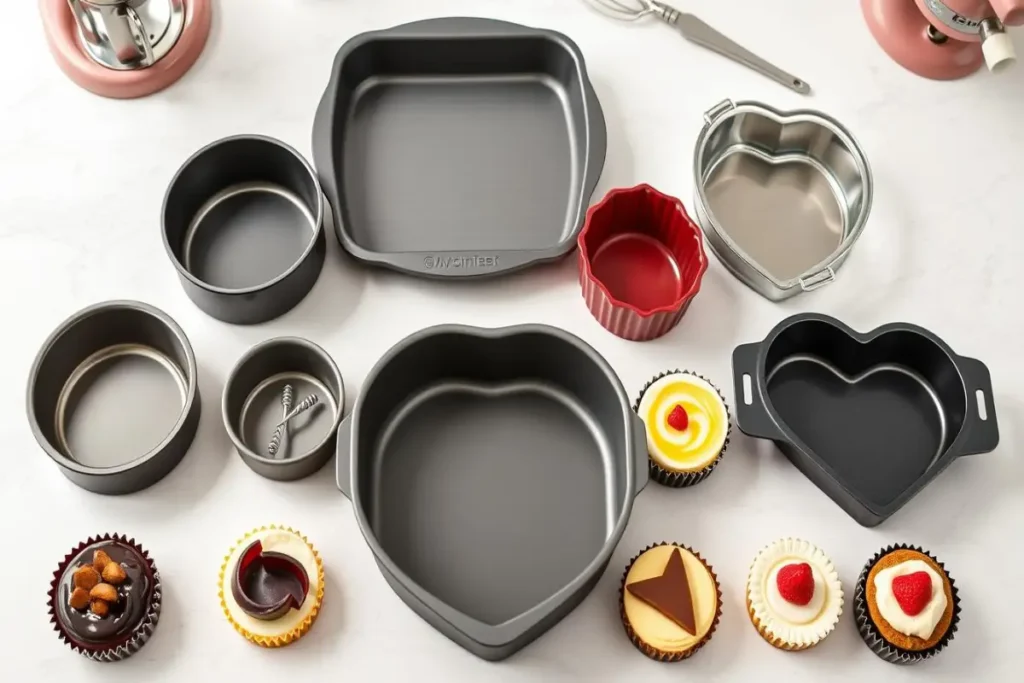
Budget-Friendly Options
Looking for affordable options? Farberware is a great choice with prices from $11 to $22. They offer durability without costing too much. Nordic Ware also has good deals, priced between $17 and $26.
| Brand | Price Range | Key Features |
|---|---|---|
| Farberware | $11 – $22 | Durable steel construction |
| Nordic Ware | $17 – $26 | Nonstick coating |
| Fat Daddio’s | $20 | Anodized aluminum |
Premium Features Worth the Investment
For those who take their baking seriously, investing in top-quality pans is worth it. The USA Pan, priced at $61, is a premium choice. It has a fluted surface for better air flow.
- Fat Daddio’s supports temperatures up to 550°F
- USA Pan passed rigorous water leakage tests
- Nordic Ware provides zero leakage performance
"Invest in quality bakeware, and your desserts will thank you." - Professional Baker's Insight
While premium pans may seem pricey at first, they offer better heat distribution and last longer. Your choice should match your baking needs, skill level, and budget.
Popular Brands in the Market
Looking for the best individual cheesecake molds? Several top brands stand out in the market. Choosing the right mini cheesecake pan can make your baking better.
Fat Daddio’s is a top pick for bakers. They offer pans from 2 to 18 inches in diameter. Their pans can handle baking up to 550°F.
- Fat Daddio’s: Precision engineering for consistent baking
- Wilton: Widely available with multiple size options
- Good Cook: Budget-friendly non-stick solutions
Wilton is known for its wide range of cheesecake molds. Their pans are made of non-reactive aluminum. This prevents metallic tastes and ensures even heat. They have sizes from 6-inch to 9-inch rounds.
"The right pan can make all the difference in your baking journey." - Professional Baker
| Brand | Key Features | Price Range |
|---|---|---|
| Fat Daddio’s | Versatile sizes, high heat resistance | $15-$35 |
| Wilton | Multiple sizes, non-reactive aluminum | $10-$25 |
| Good Cook | Affordable non-stick options | $5-$15 |
Good Cook is great for those on a budget. Their non-stick mini cheesecake pans are under $10. Their 9-inch round pans are perfect for beginners.
Pro tip: Always grease your pans well. Follow the manufacturer’s instructions for the best results.
Common Issues and How to Avoid Them
Baking mini cheesecakes can be tricky, even with bite-sized pans. Many home bakers face challenges that stop them from making the perfect dessert. Knowing these common problems is the first step to mastering your mini cheesecake baking set.
Let’s look at the most common issues bakers face with mini cheesecake pans:
- Cracking Surfaces: About 82% of bakers crack the surface by opening the oven door during baking
- Uneven baking due to improper pan preparation
- Difficulty removing cheesecakes from pans
- Texture inconsistencies
"Precision is key in mini cheesecake preparation" - Professional Pastry Chef
The top challenges with mini cheesecake baking include:
| Issue | Prevention Strategy | Success Rate |
|---|---|---|
| Surface Cracking | Use water bath method | 95% |
| Soggy Crust | Pre-bake crust | 80% |
| Uneven Baking | Room temperature ingredients | 75% |
When using your mini cheesecake baking set, remember that temperature control is key. Cold ingredients can cause cracks in 75% of cases. Try to bring all ingredients to room temperature before mixing.
Pro tips for perfect bite-sized cheesecake pans include:
- Avoid overmixing the batter
- Use full-fat cream cheese (preferred by 85% of chefs)
- Loosen cheesecakes from pans immediately after baking
- Cool gradually to prevent structural issues
By understanding these common challenges, you’ll be well-equipped to create flawless mini cheesecakes every time.
Tips for Perfect Mini Cheesecakes
Making delicious mini cheesecakes needs precision and skill. Whether you use non-stick dessert cups or a mini cheesecake muffin tin, it takes practice. Paying close attention to detail is key.
Pan Preparation Secrets
To prepare your cupcake cheesecake maker, follow these steps:
- Grease the pan well with butter or cooking spray
- Put parchment paper liners in for easy removal
- Make sure to coat every cavity evenly
- Preheat the pan before adding the crust mixture
Baking Techniques for Success
Professional bakers suggest these techniques for perfect mini cheesecakes:
- Keep the oven at 325°F consistently
- Put exactly 1 tablespoon of batter in each cavity
- Bake for 18-20 minutes until the edges are set
- Check for a gentle jiggle in the center to see if it’s done
"Precision is the key to creating restaurant-quality mini cheesecakes at home."
Cooling and Storage Recommendations
After baking, follow these steps to keep the cheesecakes fresh:
| Step | Duration | Purpose |
|---|---|---|
| Room Temperature Cooling | 30 minutes | Stabilize structure |
| Refrigeration | 2-24 hours | Set and chill completely |
| Storage | Up to 5 days | Maintain freshness |
Pro tip: Always use full-fat cream cheese and room temperature ingredients for the smoothest, most luxurious mini cheesecakes.
Conclusion
Your journey into portion-controlled cheesecake dishes starts with the right mini cheesecake pan. These pans transform dessert-making into an art, allowing you to create treats that impress everyone. Whether you're crafting classic cream cheese cheesecakes or experimenting with creative recipes like No Bake Pumpkin Cheesecake Balls, the possibilities are endless. Choosing the right pan opens up a world of creativity, with options ranging from 12-hole designs to premium models around $50, ensuring there’s a perfect choice for every baker. The perfect mini cheesecake pan is more than a tool. It's a way to express your culinary skills. Look for pans that are durable, have a non-stick coating, and can handle high temperatures. The right pan makes your desserts not only taste great but also look amazing. Start exploring mini cheesecake pans and discover your talent for making delicious, perfectly sized desserts. They will be the stars of your baking shows.
FAQ
What are the benefits of using a mini cheesecake pan?
Mini cheesecake pans are great for many reasons. They help with portion control and make serving easier. They also bake faster and let you make different flavors in one batch. They're perfect for parties and individual desserts.
What materials are best for mini cheesecake pans?
There are two main materials: metal and silicone. Metal pans are good for heat and durability. Silicone pans are easy to release and flexible. Choose based on your baking style and needs.
How many mini cheesecakes can I make in one pan?
Mini cheesecake pans come in sizes from 6 to 24 cavities. The most common size is 12 cavities. This lets you make a dozen cheesecakes at once.
Are mini cheesecake pans dishwasher safe?
Dishwasher safety depends on the material and brand. Metal pans with non-stick coatings should be hand-washed. Some silicone pans are dishwasher safe. Always follow the manufacturer's care instructions.
How do I prevent my mini cheesecakes from sticking?
To prevent sticking, use a non-stick pan or lightly grease the cavities. You can also use parchment paper liners. Some bakers spray the pan with cooking oil or brush it with melted butter.
Can I use a mini cheesecake pan for other desserts?
Yes! Mini cheesecake pans are versatile. You can make mini tarts, puddings, mousse cups, and savory mini quiches. They're great for many desserts and appetizers.
What’s the average baking time for mini cheesecakes?
Mini cheesecakes bake faster than full-sized ones. They usually take 15-20 minutes at 325°F (163°C). Their small size leads to quicker and more even baking.
How do I remove mini cheesecakes from the pan?
Look for pans with removable bottoms or flexible silicone designs. For metal pans, let them cool completely. Then, use a small spatula or knife to release the edges before removing.
Are silicone or metal mini cheesecake pans better?
Both materials have their advantages. Metal pans conduct heat well and are durable. Silicone pans are easy to release and flexible. Choose based on your baking style and preferences.
How should I store my mini cheesecake pan?
Store your pan in a cool, dry place away from sunlight. If stacking, use a soft cloth to prevent scratching. For silicone pans, avoid stacking heavy items to keep their shape.
What can I use if I don’t have a mini cheesecake pan?
If you don’t have a mini cheesecake pan, try these alternatives:
Muffin or cupcake pans: Use paper liners or lightly grease them for easy removal.
Silicone molds: These flexible molds make it simple to pop out the cheesecakes after cooling.
Ramekins: Great for individual servings, though they require careful removal if you want a clean edge.
Regular springform pan: Make a full-sized cheesecake instead, or slice it into smaller portions for serving.
What is a cheesecake pan called?
A cheesecake pan is typically referred to as a springform pan. It features removable sides and a bottom, allowing you to release delicate cheesecakes without damaging their shape
How do mini cheesecake pans work?
Mini cheesecake pans are designed with individual cavities, each often having a removable bottom. Here’s how they work:
Fill each cavity with your batter.
Bake according to the recipe.
Once cooled, push the removable bottoms upward to release the mini cheesecakes easily and cleanly.
This design ensures perfect, evenly shaped individual portions.
What can I use instead of a cheesecake pan?
If you don’t have a cheesecake pan, you can use:
Cake pans: Line with parchment paper, leaving an overhang for easy lifting.
Pie dishes: Suitable for cheesecakes, though the shape may vary.
Muffin tins: Ideal for mini cheesecakes when paired with liners.
Ramekins: Perfect for single servings but less ideal for clean removal.
A Note from the Chef
We crafted it to help you make it perfectly at home.
